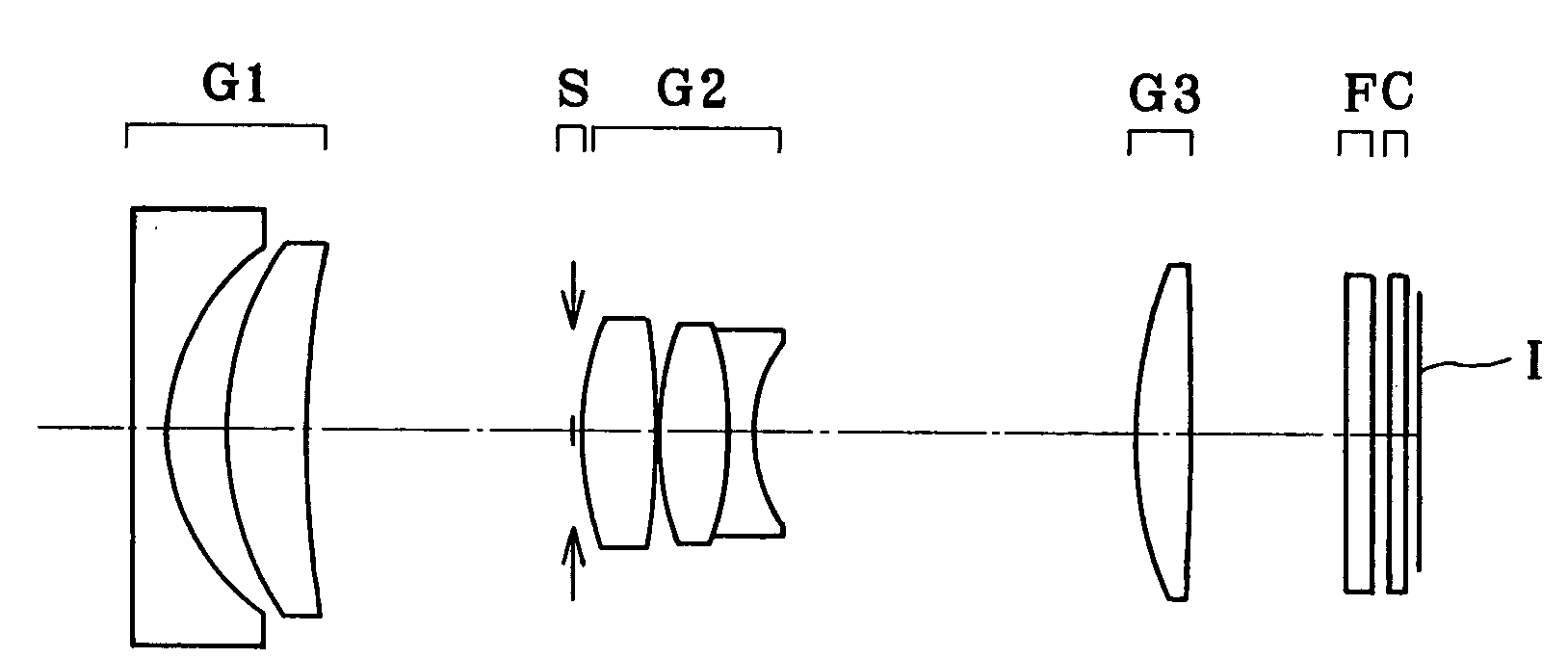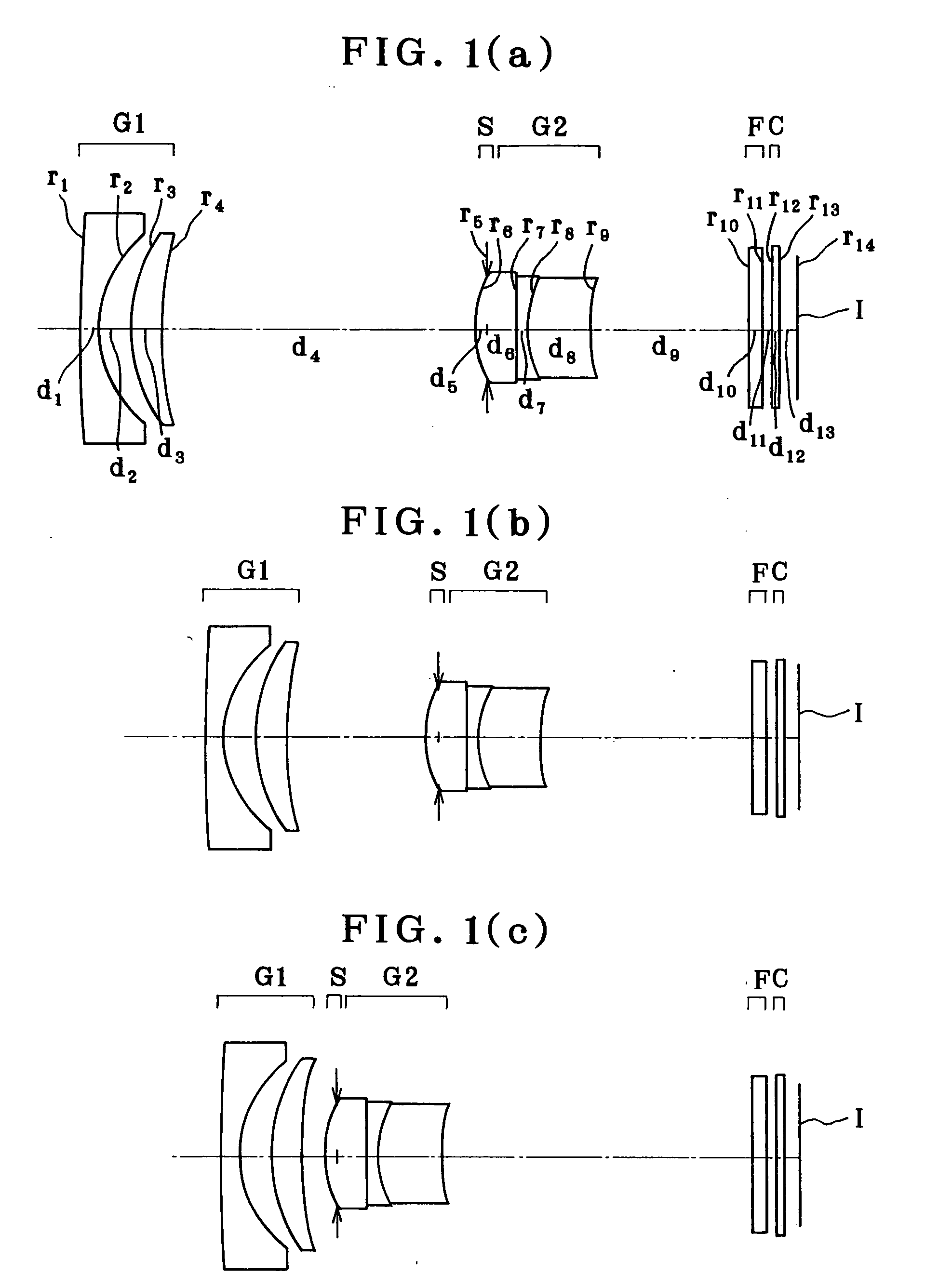Zoom lens and imaging system incorporating it
- Summary
- Abstract
- Description
- Claims
- Application Information
AI Technical Summary
Benefits of technology
Problems solved by technology
Method used
Image
Examples
examples 2-5
[0281] As depicted in FIG. 2, these examples are each directed to a zoom lens made up of, in order from its object side, a first lens unit G1 of negative refracting power, an aperture stop S, a second lens unit G2 of positive refracting power and a third lens unit G3 of positive refracting power. Upon zooming from the wide-angle end to the telephoto end, the first lens unit G1 moves in a convex locus toward the image plane side and is positioned nearer to the object side at the telephoto end than in the intermediate setting and somewhat nearer to the image side at the telephoto end than at the wide-angle end, the aperture stop S and the second lens unit G2 move together monotonously toward the object side, and the third lens unit G3 moves in a convex locus toward the object side and is positioned somewhat nearer to the image side at the telephoto end than at the wide-angle end.
[0282] In order from the object side, the first lens unit G1 is composed of a negative meniscus lens conve...
example 1
[0297]
r1 = 108.042d1 = 1.20nd1 = 1.76802νd1 = 49.24r2 = 6.708 (Aspheric)d2 = 2.10r3 = 10.793d3 = 2.02nd2 = 1.90366νd2 = 31.31r4 = 23.068d4 = (Variable)r5 = ∞ (Stop)d5 = −0.85r6 = 6.848 (Aspheric)d6 = 2.71nd3 = 1.77377νd3 = 47.18r7 = 108.781d7 = 0.80nd4 = 1.80518νd4 = 25.43r8 = 7.546d8 = 4.11nd5 = 1.58313νd5 = 59.46r9 = 29.503 (Aspheric)d9 = (Variable)r10 = ∞d10 = 0.95nd6 = 1.54771νd6 = 62.84r11 = ∞d11 = 0.55r12 = ∞d12 = 0.50nd7 = 1.51633νd7 = 64.14r13 = ∞d13 = 1.02r14 = ∞ (Image plane)Aspherical Coefficients2nd surfaceK = −0.294A4 = −7.55134 × 10−5A6 = −5.49709 × 10−7A8 = −4.99503 × 10−8A10 = 1.19213 × 10−126th surfaceK = −0.845A4 = 3.13655 × 10−4A6 = 6.27405 × 10−8A8 = 3.18418 × 10−7A10 = −5.48797 × 10−99th surfaceK = −0.299A4 = 1.52846 × 10−3A6 = −6.38153 × 10−6A8 = 8.63601 × 10−6A10 = −5.05358 × 10−7A12 = 2.28142 × 10−8Zooming Data (∞)WESTTEf (mm)8.20313.49923.275FNO3.173.895.212ω (°)60.537.121.8d421.119.712.30d99.7313.2319.70
example 2
[0298]
r1 = 486.879d1 = 1.20nd1 = 1.74330νd1 = 49.33r2 = 6.572 (Aspheric)d2 = 1.84r3 = 11.096d3 = 2.64nd2 = 1.90366νd2 = 31.31r4 = 29.983d4 = (Variable)r5 = ∞ (Stop)d5 = 0.20r6 = 9.565 (Aspheric)d6 = 2.40nd3 = 1.58313νd3 = 59.46r7 = −32.947 (Aspheric)d7 = 0.10r8 = 10.752d8 = 2.31nd4 = 1.77250νd4 = 49.60r9 = −10.752d9 = 0.70nd5 = 1.64769νd5 = 33.79r10 = 5.145d10 =(Variable)r11 = 15.888d11 = 1.74nd6 = 1.58313νd6 = 59.46r12 = −92.317 (Aspheric)d12 =(Variable)r13 = ∞d13 = 0.86nd7 = 1.54771νd7 = 62.84r14 = ∞d14 = 0.50r15 = ∞d15 = 0.50nd8 = 1.51633νd8 = 64.14r16 = ∞d16 = 0.43r17 = ∞ (Image plane)Aspherical Coefficients2nd surfaceK = −0.639A4 = −2.98759 × 10−5A6 = 3.27427 × 10−6A8 = −1.20087 × 10−7A10 = 1.35884 × 10−96th surfaceK = 0.000A4 = −2.50030 × 10−4A6 = −5.47642 × 10−6A8 = −2.75670 × 10−7A10 = 7.44525 × 10−107th surfaceK = 0.000A4 = 1.00025 × 10−5A6 = −4.46990 × 10−6A8 = −2.98489 × 10−7A10 = 5.19077 × 10−912th surfaceK = 0.000A4 = 9.29735 × 10−5A6 = −3.43799 × 10−6A8 = 5.61229 × 10−...
PUM
 Login to View More
Login to View More Abstract
Description
Claims
Application Information
 Login to View More
Login to View More - R&D
- Intellectual Property
- Life Sciences
- Materials
- Tech Scout
- Unparalleled Data Quality
- Higher Quality Content
- 60% Fewer Hallucinations
Browse by: Latest US Patents, China's latest patents, Technical Efficacy Thesaurus, Application Domain, Technology Topic, Popular Technical Reports.
© 2025 PatSnap. All rights reserved.Legal|Privacy policy|Modern Slavery Act Transparency Statement|Sitemap|About US| Contact US: help@patsnap.com



